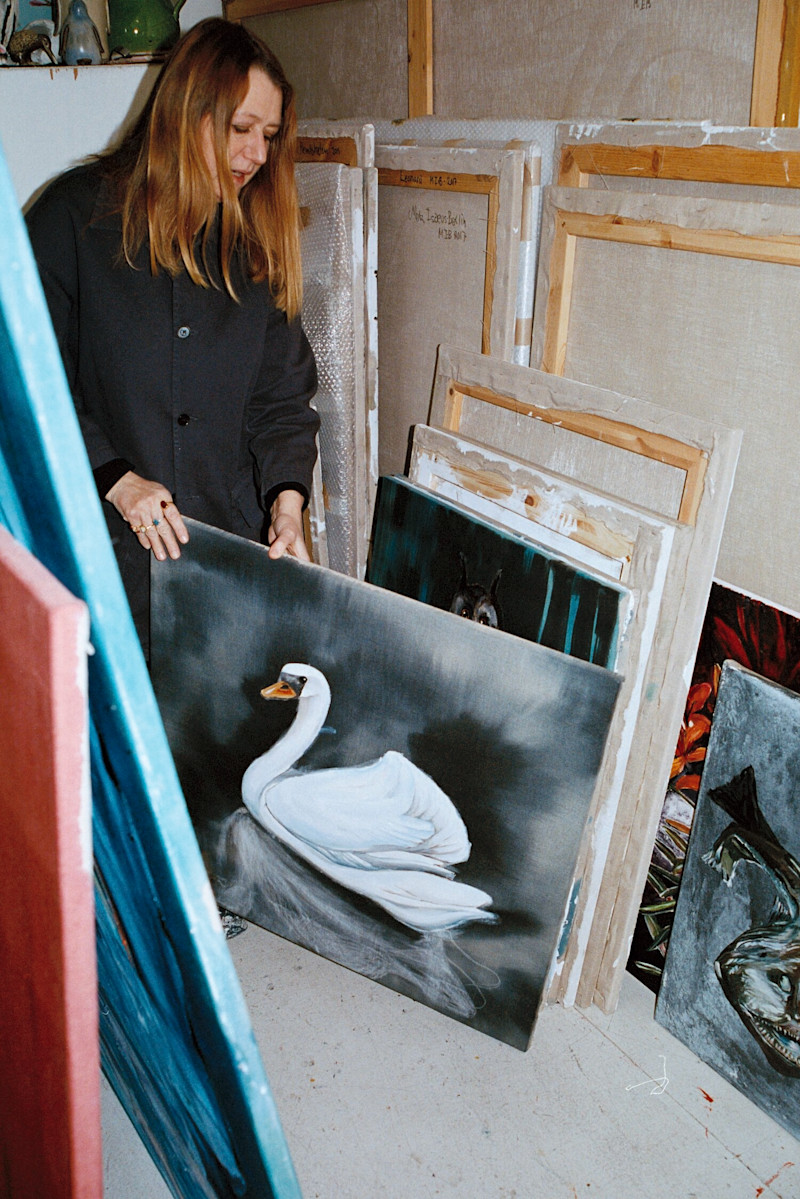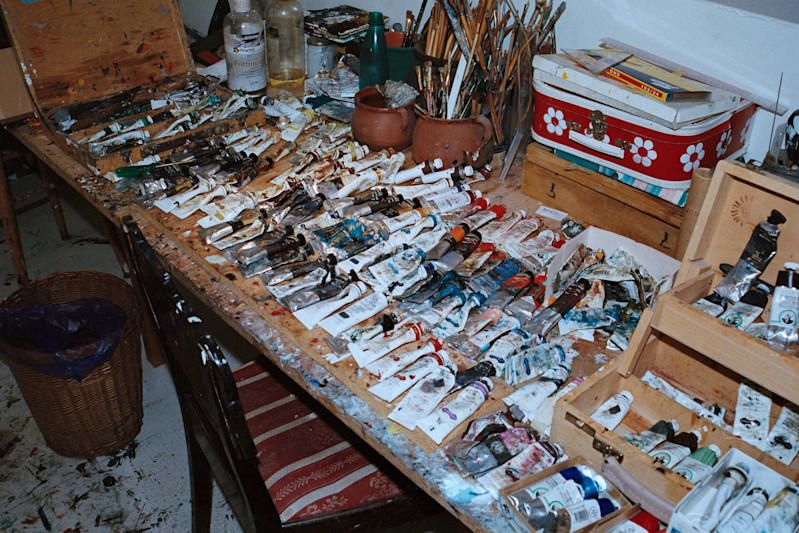Meta Isæus-Berlin in conversation with Paulina Sokolow
Interview
March 1, 2021
- Paulina Sokolow

It's been almost a year since your acclaimed exhibition at Waldemarsudde, Nocturnal Logic. As I look around your studio, I’m definitely not getting the feeling that you’ve stuck with that expression; you seem to have moved on quite a bit. Could you tell us a bit about what’s happened since then?
— It was the biggest, most significant exhibition I’ve ever done–and that includes the biennales I’ve participated in. It was an opportunity for me to address such a serious subject, using all of my techniques. And they gave me all those rooms to use! The assignment the museum director gave me was clear: “all new–this is not a retrospective!” It’s the same with this exhibition at CFHILL. I was free to continue to develop subjects. At Waldemarsudde, the exhibition was based on a specific theme. Now, I want to move on from that, so I need to work on new ideas. I held onto the idea I had of making paintings of the two bronzes, the bed–Nocturnal Logic–and the clothes–Preparation–and I continued to focus on a single object, without any scenes–just telling the story of a thing, an object. Thanks to this new technique, I suddenly found myself able to paint people. It all began with a conversation, when somebody said: “I love your sculptures, but I don’t understand your paintings.” This made me think, and reflect: what was that all about?
You mention a new technique. Could you elaborate on that?
— The new technique involves first priming the areas I intend to paint, and then dying the canvas in another colour. I mix two different colours. Then, I apply oil paint to the primed areas, and leave the canvas bare. I dye it, like a textile.
The new canvases are in the studio. In one of them, an androgynous figure appears, in a crouching pose, stooped over a stool surrounded by scraps of paper, or rather, torn sheeting. The thin strands of the frayed edges are visible from close up. Thin as nerve fibres. Just like the rest of the series, the colours are shades of black and white. White folds and shadows over compact blackness. The painted body seems almost sculpted into the air, while the dyed canvas, the backdrop, grants the surface an infinite depth. The severity and the restraint of the expression are highly reminiscent of the Spanish Baroque tradition, which was on the one hand shaped by zealous notions of religious purity in response to Protestant reinterpretations of Christianity, and on the other by geniuses like Velázquez and Goya, who somehow managed to abandon the trajectories of art history and find their own.
I’m certainly inspired by Spanish painting; both Velázquez and Goya. The lamb, for instance: I painted it black on black, like Velázquez. The lamb was primed, and the black is dyed fabric.
How would you describe this exhibition? What are the events that laid the foundations for these new works?
— The COVID-19 pandemic has been very important. It was difficult to relate to such a vast subject, but still: the way it encapsulates us all, and how all of this has to do with ways of managing the emotions that come to the surface in a situation like this, our different strategies. I can sleep it away, I can talk it away, I can love it away, I can rage it away. That’s what I want to address with this new series. They’re all wearing white clothes and making distinct movements. I wanted their hands to be clear, and their feet to be bare, throughout the exhibition. The moods are quite severe, with all that black. The red one is called Kärlek[Love]. My son is so dreadfully in love. That’s a very special phase in life, the transition into adulthood. It’s such a fragile age. You’ve just left childhood behind, and you take the step into grown-up life, all brittle. There’s so much to learn about and be hurt by.

Meta Isæus-Berlin in her studio, January 25th in Stockholm.
I need to better understand this shift in your painting. Surely, it wasn’t all motivated by somebody not liking your paintings? You must have wanted to do something else yourself, too?
— Actually, many people have chosen to side with my sculptures and installations. It’s come up now and then, as a mask, or an occasional mean face in conversations. I felt that I wanted to resolve this, and now was the time to do it. Before, I let colour be the main theme of my painting. I have a thing for colour, I need to see colour. Just holding a tube of paint is so rewarding for me. Now, I concentrated on the object, the three-dimensional effect. Realism doesn’t interest me; I find painting that way quite dull. I might as well watch TV.
You’ve used the phrase “pop-up painting”. What do you mean by that?
— My new approach to painting gave me access to a larger atmosphere. See that painting with the owl? It sinks into the canvas. It’s as though I could paint volumes of air. I feel like I’m sculpting with painting. The thin membrane of the canvas dissolves, like magic.
There are drawings in the exhibition, too. Could you tell us something about them?
— The series is titled Eskapism [Escapism]. I’ve found a new way of drawing, too, which is related to time. A longing to be somewhere else came over me, or homesickness, perhaps, while I was in quarantine on the West Coast. I began drawing with thin pencils, something I’ve never done in the past. This might be too geeky to get into, but I always used to use 6B or 8B (Editor’s Note: these grades indicate soft graphite, with high blackness). Suddenly, I took out a 2H (Editor’s Note: relatively hard, with less blackness). What could I do with that, and what could I do with a HB? Also, I’m drawing on old, inherited papers, and they demanded good drawings from me. Underneath each drawing, there are several others, which I have removed with stick erasers. I find myself sculpting on the paper now, a little like with my paintings. There are koalas, lambs, caves. No self-censorship. It’s a bit like automatic drawing, only with concrete subjects–it lifts the taboo, lets things out. I feel almost shameful as I sit there drawing, and I don’t quite know why.
“I feel like I’m sculpting with painting. The thin membrane of the canvas dissolves, like magic.”
Could you discuss the themes of the paintings some more? They remind me so much of Medieval iconography–not so much Jesus and the Virgin Mary as the more exciting peripheral subjects; the freer depictions of angels and seraphim, where there was more artistic leeway.
— In 2006, I painted Systrarna går igenom nattens händelser [Sisters Talking Through the Events of the Night] for the first time. They are my daughters. In 2011, I painted the same subject again, and that painting now hangs in the Stockholm School of Economics. The subject remains highly topical. I repainted it using my new technique; it was the first painting I made this way. An intimate conversation. In one of the paintings, it’s windy, and the figure is shielding a flame. That one is about not losing hope. Keeping the flame burning. I also painted the truth, the angry one. It’s an internal image, one I think many of us carry around inside. It’s like The Scream.
The lamb and the owl stand out. They’re somehow embedded in the paintings, somewhere just below the surface.
— Yes, it’s a new born. I was there for a lambing while I was on the West Coast. She has been such a comfort to me, Carmen, and after witnessing her birth, I became a vegetarian. They are so pure, absolutely new-born lambs; so fragile and naked and wet. They look at the world around them with such wonder and helplessness. It oozes from them.
I’m so glad you brought up the oozing theme! It’s been there throughout your oeuvre, and it remains in this work, although you’ve dialled it down somewhat this time. Sculpted hands, and this lamb.
— In my installations, water takes the place of human beings. Emotions were presented in the form of water. I made my first fountains when I was still quite young. For example, I would dig at the beach until I found water. Water represents joy and liberation, a source of inspiration as well as purification. You can rinse your thoughts away, as a kind of mental purification. It has it all–the depths, the surface–and it makes you want to explore all of its levels. Water is a state. You can express so much with water, with the depths. And you can also joke with water, like when you hear the water running in The Leak, where the coffee pours for all eternity in a coffee break that never ends. You mustn’t forget the funny side of life.

Meta Isæus-Berlin in her studio, January 25th in Stockholm.
OK, Meta. I think we might have touched on most aspects of the new exhibition. However, we haven’t yet mentioned the largest new piece, which you were inspired to create after you made yourself at home in the grand gallery at CFHILL: Frukost [Breakfast].
— Yes. I’m not so much interested in the foods you eat as I am in the state of emerging from sleep in the morning. I’m interested in the fragility of waking up, and the importance of caring for your inner life. It has to remain intact until the world outside requires you to emerge from your bubble, your wishes be damned. That’s what waking up and having to live is like. I love living, but it’s difficult, right? You awaken to the world. That’s what it’s like for all people, for everybody–even the king.
Why is the exhibition titled Återsken [Reflection]?
— The exhibition is titled Återsken [Reflection] because the problem is that when you see the moonlight, what you really look at is the reflection in the water, not the moon itself. You look at what happens when something else happens. That’s what feeds the artistic impulse.



